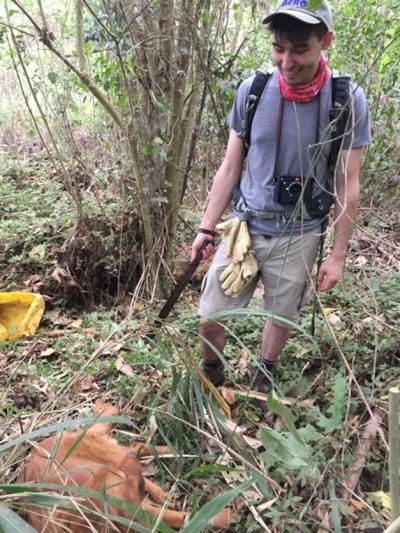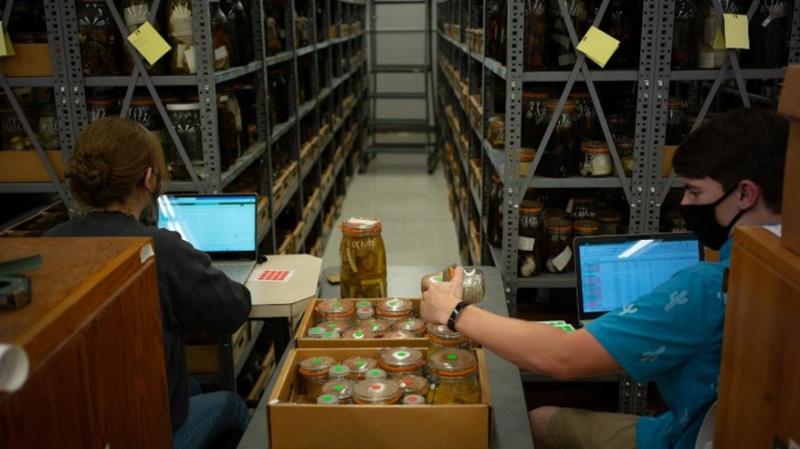
I’m Nate Shoobs, the (relatively) new curator of the Mollusk Division and Crustacea Division at the Museum of Biological Diversity. I am an invertebrate zoologist and evolutionary biologist, and I study the systematics and evolutionary ecology of rare and endangered neotropical land and freshwater snails, especially those on volcanic archipelagos (Galápagos; the Lesser Antilles). Before being hired here at Ohio State in March of 2021, I worked at the third largest mollusk collection in the world: the Department of Malacology at the Academy of Natural Sciences of Philadelphia/Drexel University. I received my MSc at Drexel in late 2019 and remain a research associate of the ANSP.
My dedication to basic taxonomic research and collections work is motivated by the knowledge that we are in the midst of a mass extinction, the magnitude of which is obscured because poorly known but spectacularly diverse invertebrates — particularly non-marine mollusks — are disproportionately affected. I firmly believe we cannot effectively study biodiversity, nor can we prevent its loss, without maintaining and continually improving biological collections like those we have at the Museum of Biological Diversity.
The museum’s Mollusk Division is one of the largest collections of mollusks in the world, with significant holdings of extinct and extirpated species of North American snails and mussels. It is also a major center of conservation research on freshwater mussels and is one of the most important sources of information about North American freshwater mussel species that currently exists. I consider it a privilege and a great responsibility to be able to make my living caring for such important resources.
When I started on the job in March, I had never before set foot in the Midwest, I didn’t know how to identify a single species of freshwater mussel and I didn’t know anything about the curatorial practices in the collection. Because my role at the Museum of Biological Diversity is primarily to run the invertebrate collections, my neotropical land snail research has taken a back seat this year while I have been getting my bearings and working to reactivate the essential functions of the division (which had been largely dormant from 2019-2020). Short staffing and the museum’s COVID-closure had a major impact on the collection, which I’ve been able to mitigate only with the help of some excellent volunteers (Sara Klips, Mike Hoggarth and Mike Bolton) and colleagues at the museum who helped me hit the ground running. I’ve been extremely lucky as well in having found some dedicated students (Rory Schmidt, Ava Johnston, Emily Barber, and Sylvia Rossi) who have gone above and beyond in their work to improve the collection.

Since March, we have: inventoried and assessed the status of 44% of our 20,000-lot wet specimen collection, inventoried 4200+ drawers of dry specimens, 3000+ boxes of uncatalogued material, and ca. 60 boxes of uncatalogued vouchers. We’ve also digitized 100% of our original handwritten collection catalogues and accession ledgers and roughly 30-40% of our archival field notes in our archives, which we hope to provide online as linked media in our collection database. We have reopened the collection to scientific visitors (100+), loan requests (2), Ohio State Mussel ID test takers (30+), and hosted an Ohio Freshwater Mussel Workshop in October with 28 attendees. Most importantly, I can now identify all of Ohio’s native freshwater mussel species without totally embarrassing myself.
This summer I’m looking forward to doing some land and freshwater snail collecting across the state, as there are major gaps in our knowledge of the state’s snail diversity, especially when compared with our knowledge of the mussel fauna.
In all, I’m thrilled to be a part of Ohio State and the Museum of Biological Diversity, and I am excited to take on new curatorial and research projects with students and colleagues alike.
